
A strengthening storm system over the Upper Great Lakes will bring moderate to heavy snow to the Upper Peninsula of Michigan through Tuesday morning. Ahead of this system, strong to severe storms may develop over the Ohio Valley, portions of the Appalachians, and the Mid Atlantic Monday. Read More >
Storm Surge OverviewSurge Overview | Storm Surge Unit | SLOSH | P-SURGE | Surge Products | Local Impacts | FAQ | Resources
Contents
IntroductionAlong the coast, storm surge is often the greatest threat to life and property from a hurricane. In the past, large death tolls have resulted from the rise of the ocean associated with many of the major hurricanes that have made landfall. Hurricane Katrina (2005) is a prime example of the damage and devastation that can be caused by surge. At least 1500 persons lost their lives during Katrina and many of those deaths occurred directly, or indirectly, as a result of storm surge.
Storm Surge vs. Storm TideStorm surge is an abnormal rise of water generated by a storm, over and above the predicted astronomical tides. Storm surge should not be confused with storm tide, which is defined as the water level rise due to the combination of storm surge and the astronomical tide. This rise in water level can cause extreme flooding in coastal areas particularly when storm surge coincides with normal high tide, resulting in storm tides reaching up to 20 feet or more in some cases.
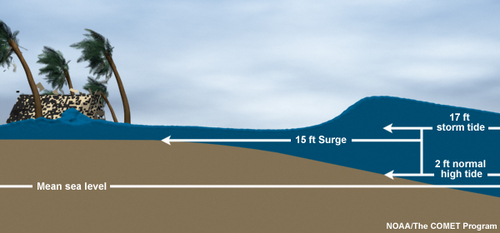 Storm Surge vs. Storm Tide Factors Impacting SurgeStorm surge is produced by water being pushed toward the shore by the force of the winds moving cyclonically around the storm. The impact on surge of the low pressure associated with intense storms is minimal in comparison to the water being forced toward the shore by the wind.
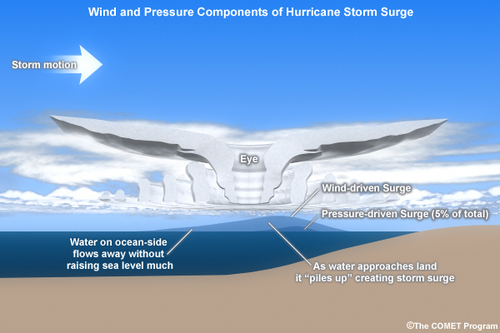 Wind and Pressure Components of Hurricane Storm Surge The maximum potential storm surge for a particular location depends on a number of different factors. Storm surge is a very complex phenomenon because it is sensitive to the slightest changes in storm intensity, forward speed, size (radius of maximum winds-RMW), angle of approach to the coast, central pressure (minimal contribution in comparison to the wind), and the shape and characteristics of coastal features such as bays and estuaries. 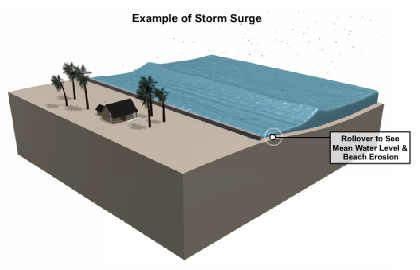 Click on Image to Play Video Other factors which can impact storm surge are the width and slope of the continental shelf. A shallow slope will potentially produce a greater storm surge than a steep shelf. For example, a Category 4 storm hitting the Louisiana coastline, which has a very wide and shallow continental shelf, may produce a 20-foot storm surge, while the same hurricane in a place like Miami Beach, Florida, where the continental shelf drops off very quickly, might see an 8 or 9-foot surge. More information regarding storm surge impacts and their associated generalizations can be found in the FAQ section. 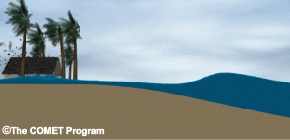 Surge animation with shallow continental shelf (Click on Image to Play Video) 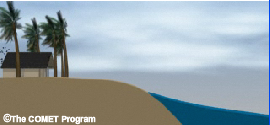 Surge animation with steep continental shelf (Click on Image to Play Video) Adding to the destructive power of surge, battering waves may increase damage to buildings directly along the coast. Water weighs approximately 1,700 pounds per cubic yard; extended pounding by frequent waves can demolish any structure not specifically designed to withstand such forces. The two elements work together to increase the impact on land because the surge makes it possible for waves to extend inland. 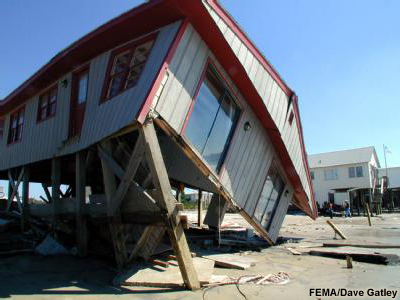 Although elevated, this house in North Carolina could not withstand the 15 ft (4.5 m) of storm surge that came with Hurricane Floyd (1999)
Additionally, currents created by tides combine with the waves to severely erode beaches and coastal highways. Buildings that survive hurricane winds can be damaged if their foundations are undermined and weakened by erosion. 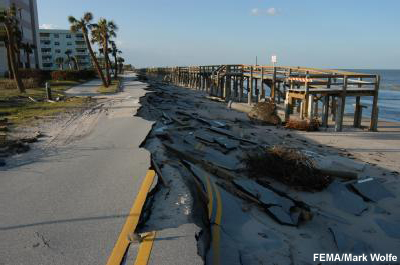 Beachfront road and boardwalk damaged by Hurricane Jeanne (2004)
In confined harbors, the combination of storm tides, waves, and currents can also severely damage marinas and boats. In estuaries and bayous, salt water intrusion endangers the public health, kills vegetation, and can send animals, such as snakes and alligators, fleeing from flooded areas. 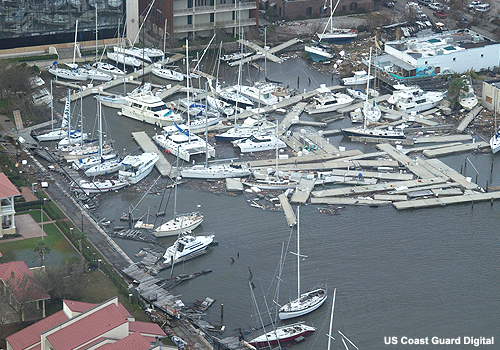 Damaged boats in a marina
Notable Surge Events
Surge Vulnerability Facts
|
| Quick Navigation Links: Tropical Cyclone Forecasts - Tropical Marine Forecasts - Data Archive Outreach - Prepare - About Cyclones - About NHC - Contact Us |